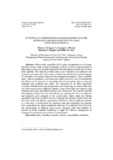| dc.contributor.author | Linguya, Kimaru S | |
| dc.contributor.author | Wangai, Kimenju J | |
| dc.contributor.author | Chao, Kilalo D | |
| dc.contributor.author | Moraa, Onyango C | |
| dc.date.accessioned | 2016-05-24T15:54:06Z | |
| dc.date.available | 2016-05-24T15:54:06Z | |
| dc.date.issued | 2015 | |
| dc.identifier.citation | Journal of Agricultural Sciences, Belgrade 2015 Volume 60, Issue 3, Pages: 301-314 | en_US |
| dc.identifier.uri | http://www.doiserbia.nb.rs/Article.aspx?id=1450-81091503301L&AspxAutoDetectCookieSupport=1#.V0R3D-TG7Gs | |
| dc.identifier.uri | http://hdl.handle.net/11295/95907 | |
| dc.description.abstract | African leafy vegetables (ALVs) play an important role as income and food security crops in many households in Kenya. However, their potential in alleviating poverty and ensuring household food and nutrition security has not been fully exploited. The objectives of this study were to identify some arthropod and nematode pests that infest ALVs and to evaluate the effectiveness of intercropping of susceptible and resistant plants for the management purposes. Three vegetable types: African nightshade, sunn hemp and spider plant were used in determining the efficacy of an intercrop of susceptible and non-susceptible types in reducing arthropod and nematode pest effect. The treatments in the field experiment consisted of different intercrop designs and a sole crop design as control while data was taken based on five different variables. Crops in the field were infested with arthropod pests and eight different species were enumerated. The same row and hill intercropping designs were the most effective in reducing the effect of arthropod and nematode pests compared to the control plots. Spider plant and African nightshade intercrops recorded the least arthropod pest damage, higher fresh and dry shoot yields and differed significantly (P≤0.05) to African nightshade planted as a sole crop. A similar trend was observed when the experiment was repeated with a sunn hemp and African nightshade intercrop. It is concluded from this study that intercropping of different crops can be integrated with other methods to provide an easily adaptable technology to apply for effective management of arthropod and nematode pests with low external inputs | en_US |
| dc.language.iso | en | en_US |
| dc.rights | Attribution-NonCommercial-ShareAlike 3.0 United States | * |
| dc.rights.uri | http://creativecommons.org/licenses/by-nc-sa/3.0/us/ | * |
| dc.subject | Leafy vegetables | en_US |
| dc.subject | Juveniles | en_US |
| dc.subject | Efficacy | en_US |
| dc.subject | Susceptibilitytodes | en_US |
| dc.title | Potential of intercropping for management of some arthropod and nematode pests of leafy vegetables in Kenya | en_US |
| dc.type | Article | en_US |



